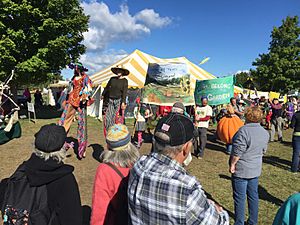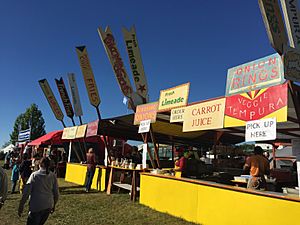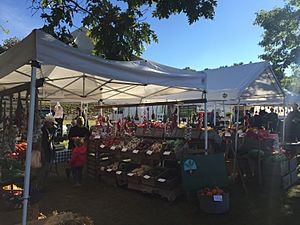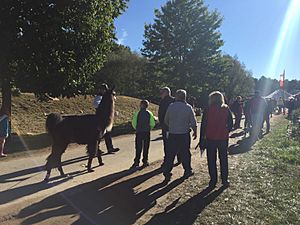Common Ground Country Fair facts for kids
The Common Ground Country Fair is a special event in Unity, Maine. It happens every year in early September. This fair celebrates organic living, farming, and growing. It is put on by the Maine Organic Farmers and Gardeners Association (MOFGA). All the food you can buy at the fair is organic. Many people visit, usually between 50,000 and 60,000!
Contents
History of the Fair
How the Fair Started
The Common Ground Country Fair first began in 1977 in Litchfield, Maine. It was a way to raise money for MOFGA. The first fair raised $22,000. In 1981, the fair moved to Windsor, Maine. Then, in 1996, MOFGA bought 200 acres of land in Unity, Maine. This is where the fair has been held every year since.
An article from 1977 mentioned the fair would have "extra features." These included talks by famous homesteaders, Helen and Scott Nearing. People had limited expectations for the fair back then.
A writer named Lloyd Ferris shared his memories of the 1977 fair. He remembered a huge tent that looked like a pyramid. Inside, there was amazing food. People loved the egg rolls, sandwiches, homemade ice cream, and baked goods. There was also a warm cider drink called swichel.
Changes Over the Years
In 1989, Hurricane Hugo caused flooding at the fairgrounds. This delayed the opening on Saturday.
In 2008, MOFGA tried something new. They added water bottle filling stations. This was to see if they could stop selling bottled water. It worked well! The next year, no bottled water was sold at the fair.
For many years, coffee was not sold at the fair. But by 2011, vendors could sell organic, fair-trade coffee.
In 2017, the fair used only clean energy sources. This included a large solar power system and wind turbines.
In May 2020, MOFGA announced the fair would not happen. This was the first time it was canceled since it started. The reason was the COVID-19 pandemic. Instead, they planned a special online event.
What to Expect at the Fair
The fair is a fun place to learn and explore. You can see demonstrations of traditional skills. These include spinning, weaving, and woodworking. There are also demonstrations about alternative energy. Many vendors sell handmade crafts. You can find fresh produce at the farmers' markets. The food courts offer a wide range of organic foods.
Many groups that work for social change also attend the fair. They share information about important topics.
In 2012, a writer from The New York Times visited the fair. She said it was a big celebration for many people. This included organic farmers, craftspeople, and animal handlers. There were also poets, musicians, and experts on solar power. She noted that the air smelled like sweet Annie, an herb. Many people wore crowns made of it.
The Portland Press Herald reported in 2013 that the fair is different from typical fairs. Instead of cotton candy and carnival rides, you find veggie burgers. You can also attend workshops on things like worm composting.
The fair is well-known for its many vegetarian, vegan, and gluten-free food options. A food writer said in 2014 that the Common Ground Country Fair is the best for meat-free choices. The Maine Campus newspaper also noted in 2019 that it has many more vegan and vegetarian options than other fairs.
Inspiring Speakers
Each day at the fair, there is a main speaker. This person gives a special talk called a keynote address. There are also hundreds of other talks, discussions, and educational events. Some past keynote speakers include Wendell Berry, Scott Nearing, and Vandana Shiva.
Poster Art Contest
MOFGA holds a contest every year. Artists create designs for the next fair's poster and merchandise. People who live in Maine and MOFGA members can enter. Past winning artwork has included a painting by Dahlov Ipcar in 1987. In 2011, a painting of canned goods won. A drawing of medicinal herbs won in 2014. The 2018 poster showed two kunekune pigs. The artist painted them to show livestock not raised for meat.





